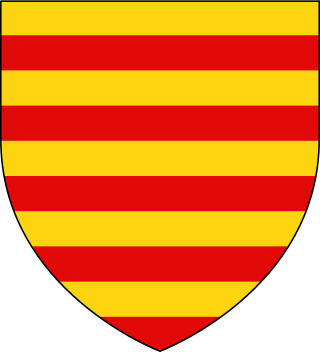Related Research Articles
Albert I the son of Robert I, was a count who held the castle of Namur and a county in the Lommegau. His county came to be referred to as the County of Namur in records during his lifetime.

The County of Loon was a county in the Holy Roman Empire, which corresponded approximately with the Belgian province of Limburg. It was named after the original seat of its count, Loon, which is today called Borgloon. During the middle ages the counts moved their court to a more central position in Kuringen, which is today a part of Hasselt, the modern capital of the region.
Giselbert van Loon is the first definitely known count of the County of Loon, a territory which, at least in later times, roughly corresponded to the modern Belgian province of Limburg, and generations later became a lordship directly under the Prince-bishopric of Liège. Very little is known about him except that he had two brothers, one of whom, Bishop Balderic II of Liège, is much better attested in historical records.

Louis I was the Count of Loon, now in modern Belgium, and Burgrave of Mainz, in Germany. He inherited these offices from his father. He also established the County of Rieneck apparently based upon the Burgrave's lands.
The counts of Chiny were part of the nobility of Lotharingia that ruled from the 9th to the 14th century in what is now part of Belgium.
Count Nibelung or Nevelung, son of Count Ricfried and his wife Herensinda. He was probably his father's heir, and like his father he was probably a count in Betuwe (Batavia), and more generally in the Rhine-Meuse-Scheldt delta region, now in the Netherlands, and the neighbouring northern Rhineland in Germany. His better-known brother was Bishop Balderic of Utrecht.
Rudolf or Rodolphe, was a Lower Lotharingian noble born into a family with connections to Utrecht. He is thought by some modern interpreters to have later had lordships in the Hesbaye region which is now in Belgium, in a part which mostly came to be incorporated into the later County of Loon. He was a son of Nevelung, Count of Betuwe, and a daughter of Reginar II, Count of Hainaut, whose name is not known. He had two uncles, one paternal and one maternal, who were both named Rudolf, and various proposal have been made about how the three Rudolfs correspond to various references to "Count Rudolf" in the 10th century "low countries". Although his paternal uncle Rudolf is sometimes considered to have become a cleric, Jongbloed (2006) argued that he must have been a count, and that he certainly had a wife and offspring. There is no contemporary record of young Rudolf, the nephew, as a count, nor indeed as an adult.
Otto is a purported Count of Loon and father of Count Giselbert, who would have been adult roughly around the years 980–1000. He appears in only one much later document that is considered unreliable, so his existence is doubted. The list of the counts of Loon is normally started with Giselbert.
Arnold I, Count of Loon (Looz) from about 1079, son of Emmo, Count of Loon, and Suanhildis, daughter of Dirk III, Count of Holland, and his wife Othelandis.

Arnold II, Count of Loon, son of Arnold I, Count of Loon, and Agnes von Mainz, daughter of Gerhard I, Count of Rieneck, and Helwig von Bliescastel. He is distinguished from his father of the same name by historians who note records for counts named Arnold or Arnulf between 1179 and 1141. The first Arnold must have died between 1125 when Count Arnold appears in a record with his son also named Arnold, and 1135, when a new Count Arnold appears with his own son and successor Louis.
Count Gerard of Loon, was son and successor of Louis I, Count of Loon, and Agnes of Metz. He was count of Loon and of Rieneck. Because of a widespread misunderstanding concerning a document from 1101, some generations earlier, he is sometimes wrongly referred to as the second Gerard in this dynasty, "Gerard II".
Louis III, Count of Looz, also known as Ludwig was Count of Loon and of Rieneck. He was the son of Gerard, Count of Rieneck, and Cunegonde von Zimmern, who was in turn the son of another Count Gerard who was also count of both Rieneck and Loon.
Count Rudolf, was a count in Lower Lotharingia, who apparently held possessions in the Hesbaye region and in the area of Meuse river north of Maastricht. It has been proposed that he was a son of Reginar II, Count of Hainaut, and thus a member of the so-called Regnarid dynasty.
Count Emmo, Immo or Immon, was the name of at least one important Lotharingian nobleman in the 10th century, described by medieval annalists as a cunning strategist. Various life events of a nobleman of this name were recorded, although historians differ about exactly which records refer to the same person or people. The first record claimed for him shows him as a young noble granting land to a new vassal in the Condroz region in 934, a member of the entourage of Duke Gilbert of Lotharingia. During the revolt of Gilbert which ended at the Battle of Andernach in 939, he switched sides. After the revolt he was personally associated with the fort at Chèvremont, near Liège. It becomes difficult later in Immo's life to be sure that all records mentioning a count of this name are referring to the same person.
The County of Duras was a medieval county with its seat at the castle of Duras. The 18th century version of this castle still stands and is a part of modern Sint-Truiden in the province of Belgian Limburg. The county was one of several counties in the Hesbaye region which covers the south of Belgian Limburg, and stretches into the neighbouring provinces. As a distinct entity under the name Duras the county only existed within the 12th century. After the first male line of counts died out, the county of Duras came by marriage to the Counts of Montaigu, whose other holdings were further south. Later they became part of the neighbouring County of Loon, which was ruled by cousins of the original counts of Duras.
Count Otto of Loon as he was known during his own lifetime, was founder of the family of Counts of Duras, and brother of Emmo, Count of Loon, one of the first known counts of Loon. In contemporary and later medieval records he is mainly known for his role as advocate of Sint-Truiden Abbey, which is today in Belgian Limburg.
Count Giselbert of Loon or (later) Duras, was the deputy advocate (subadvocatus) of Saint Trudo’s Abbey. He was son of Otto I, Count of Duras, and his wife Oda. Giselbert was the first person to be named in contemporary documents as a count of Duras.
Count Otto of Duras was a Count of Duras, and advocatus of the Abbey of St Truiden. Duras and St Truiden are in the modern province of Belgian Limburg. His parents were Count Giselbert of Duras and his wife Gertrud.
Baldrick II was bishop of Liège from 1008 to his death at Heerewaarden in what is now the Netherlands.
Sophia of Loon was the Queen of Hungary, the first wife of Géza I of Hungary. According to the old Hungarian sources, she was the daughter of the Limburg duke Arnulf, the son of Rudolph, duke of Limburg, and countess Luitgard of Namur. In reality Arnulf might be Arnulf, Count of Holland, the father of Dirk III or Arnulf of Haspinga ; and Luitgard might be Luitgarde of Namur, her paternal grandmother; thus, Rodolph was her paternal great-grandfather, who can possibly be identified with Richwin II, Castelijn of Baelen-Limbourg (1033).
References
- ↑ Vita Arnulfi Episcopi Suessioniensis, MGH SS 15.2, Holder-Egger ed. (Hannover 1888) p.879.
- ↑ See pedigree p.149 Vaes, Jan (2016), De Graven van Loon. Loons, Luiks, Limburgs, ISBN 9789059087651